The Fens Loop
Hailing Distance: One of a series of great half-hour hikes from campus
Dub this walk “The Transformer.”
Punctuated with world-class museums, community gardens, athletic fields, and war memorials, this stroll offers enough interesting look-sees and route extensions to mix things up, stretching a 20-minute amble into an afternoon excursion. So pack your appetite, culinary and cultural (with an audacious crime story on the menu), and plunge into the Fens.
From Marsh Chapel, head up St. Mary’s Street. Take a left at Mountfort Street, where a bend to the right will shoot you onto Park Street. Before getting into the thick of it, fuel up with a tasty pancake wrap at Crispy Crêpes Café (from egg-and-sausage stuffing to sweet Nutella ooze).
Once you’ve wiped away the crumbs, cross Beacon Street at Audubon Circle; there’s a nice view of the Citgo sign rising to the left. On the other side of Beacon, cross over the Fenway T tracks and pass the Landmark Center’s distinctive tower capped with a fluttering American flag. The art deco building, formerly Sears, Roebuck and Company, was built in 1929 and can be seen from vantage points on campus and beyond. The massive commercial fortress houses a Staples, a Best Buy, an REI, several eateries, and the Regal 13 Cinema.
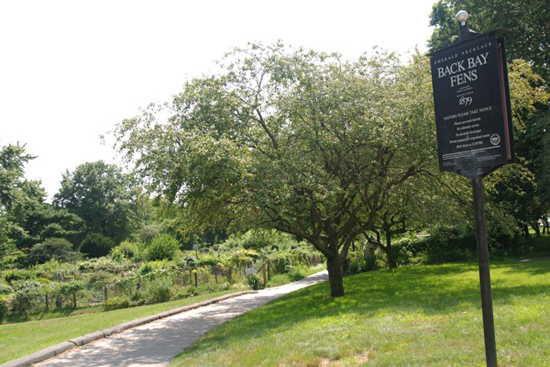
Straight ahead, across Boylston Street, is the Back Bay Fens, known near and far as simply the Fens. This urban wild is part of the Emerald Necklace system, a chain of nine Boston parks designed or improved by 19th-century landscape architect Frederick Law Olmsted, of Manhattan’s Central Park renown. The Fens gives its name to the Fenway-Kenmore neighborhood and to Fenway Park, home of the Red Sox.
The Muddy River snakes through the Fens, with wildlife grooming or preening at the water’s edge, and the gravel paths are soothing on asphalt-hardened feet. Taking the Fenway side makes it easy to head for the Isabella Stewart Gardner Museum.
The puddle-shaped Fens is “saltwater marshland which has been surrounded by dry land, disconnected from the tides of the Atlantic Ocean, and landscaped into a park with fresh water within,” according to the Emerald Necklace Conservancy, which provides stewardship and support for the parks. Noted landscape architect Arthur Shurcliff later added the Kelleher Rose Garden and ball fields. Just beyond the rose garden stand memorials honoring Boston soldiers who fell during World War II, Vietnam, and Korea. The spot is a nice place to picnic, but watch your step: the turf is sometimes studded with fresh goose cigars. The Fens is also considered a birdwatcher’s paradise, with many winged creatures lurking in its marshes and tall reeds. You can find a running track and basketball courts within its confines, too. As with most city parks, gallivanting after dark is not advised.
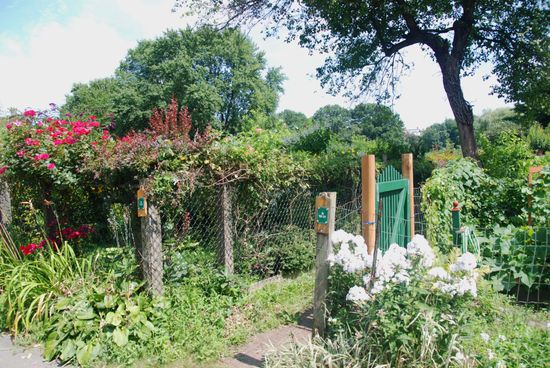
The Fens is home to the city’s oldest continuously operating victory garden, the Richard D. Parker Memorial Victory Gardens. After America entered World War II in 1941, food demands for the troops abroad led to rationing and shortages at home. President Roosevelt urged Americans to grow more vegetables and herbs. Boston established 49 public plots for this purpose (including land in the Boston Common and the Public Garden). Only the Fens soil continues to bear bounty.
On the way to the Gardner, pass Simmons College, Wheelock College, and Emmanuel College. In fact, quite a few educational institutions ring the Fens, including Harvard Medical School, Boston Latin School, Mass College of Art, the School of the Museum of Fine Arts, and the back of Northeastern University. On the Park Drive side of the Fens, traffic noise sometimes mixes with tuba scales or cello strains coming from students in Boston Conservatory practice rooms.
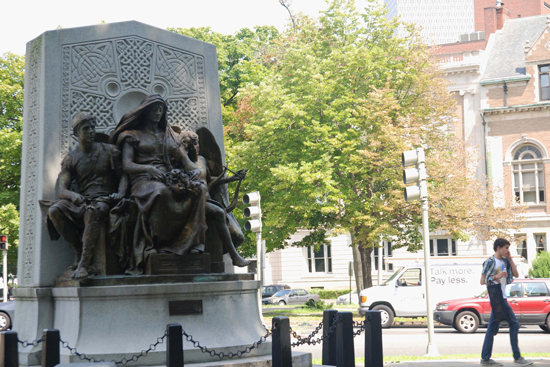
About 20 minutes after striking out, the front gate of the Gardner museum appears. The outside is a nondescript brick affair, but inside, it’s one-of-a-kind, from an Italianate layout to the eclectic mix of art and absence (for the most part) of identifying information on the walls.
Born in 1840, “Mrs. Jack” was a patron of the arts and a major Boston personality. She and her husband hosted dinner parties for the likes of authors Henry James and Sarah Orne Jewett, philosopher George Santayana, and abolitionist and poet Julia Ward Howe, as well as artists such as John Singer Sargent and James McNeill Whistler. The Gardners traveled the world collecting art, but were especially fond of Italy, Venice in particular.
In 1903, Gardner built Fenway Court in Boston to house her collection, installing her works “in a way to evoke intimate responses to the art, mixing paintings, furniture, textiles, and objects from different cultures and periods among well-known European paintings and sculpture,” according to the museum. After-hours concerts, from chamber music to jazz, are staged in the Tapestry Room gallery. The pièce de résistance, however, is the Venetian-style inner courtyard, with its covered glass roof. In the courtyard, decorated with sculptures, gargoyles, and fountains, plants and flowers riot all over. Visitors can take in the scene from cool stone benches at ground level or from ornate carved windows on upper floors.
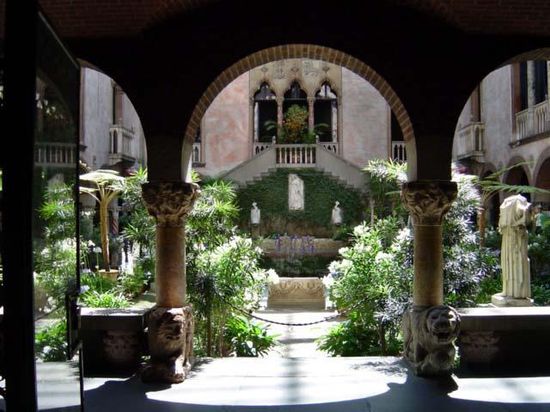
When Gardner died in 1924, her will established a $1 million endowment and stipulated that her collection not be significantly altered. A couple of brazen thieves would violate those terms 66 years later, pulling off the biggest art theft in history.
Shortly after midnight on March 18, 1990, men disguised as Boston police officers talked their way into the museum and handcuffed two security guards. They stole 13 pieces valued at more than $500 million, including The Concert, one of Johannes Vermeer’s 34 known paintings, and 3 works by Rembrandt van Rijn, including his only seascape, The Storm on the Sea of Galilee, and a small self-portrait print. They also snatched a series of drawings by Edgar Degas and works by Édouard Manet and Govaert Flinck, as well as a Chinese Ku, or beaker, and a finial from a Napoleonic flag.
Empty frames now hang in the Dutch Room, where the Vermeer, Flinck, and two Rembrandts once lived, “as an homage to the missing works and a placeholder for their return,” says museum director Anne Hawley. A reward of $5 million is offered for information leading to the return of the works (in good condition). Keep an eye out as you walk.
There’s a nice outdoor seating area near the garden grounds, where museum visitors can take in more greenery and horticulture.

Once done with the Gardner, you can keep the art ambiance going by getting back on the Fens path and heading to the Museum of Fine Arts, which attracts more than a million visitors a year. Founded in 1870, the MFA houses more than 450,000 pieces, one of the most comprehensive collections in the Americas.
The Fens path winds along for another mile or so beyond the MFA, looping past Fenway Park, back toward the Landmark Center and campus. That trek nudges this urban hike over the half-hour mark, but with plenty of run- and bike-friendly paths, carving out a unique, efficient route isn’t a problem.
This article was originally published on November 19, 2009.
Take more walks from campus here.
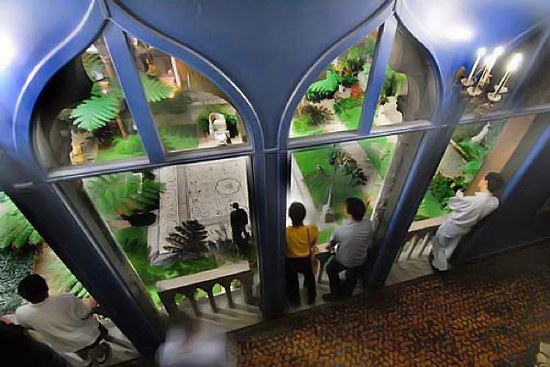
Looking into the courtyard of the Isabella Stewart Gardner museum, one stop along a scenic walk through the Back Bay Fens. Photos by Nelia Ponte
Comments & Discussion
Boston University moderates comments to facilitate an informed, substantive, civil conversation. Abusive, profane, self-promotional, misleading, incoherent or off-topic comments will be rejected. Moderators are staffed during regular business hours (EST) and can only accept comments written in English. Statistics or facts must include a citation or a link to the citation.